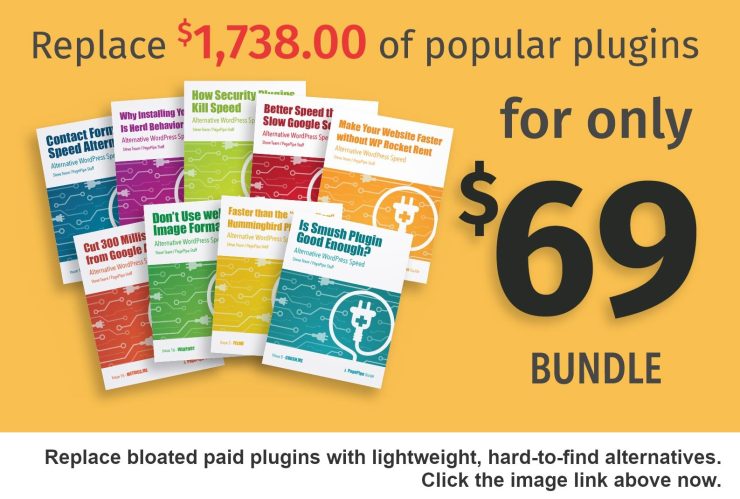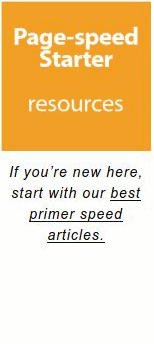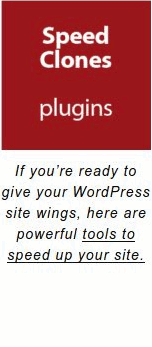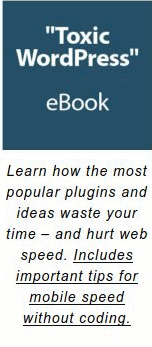We generally think image sliders are a bane. We’ve written about the problems before. But if your client is insistent upon having a slider to show a gallery of photos, what should you do?
First convince the client of the negative aspects of a slider – especially if better SEO is their defense. (See the links at the bottom of this article). Using a slider for presentation is not a bad thing. But offload it from the Home page to a page of it’s own. And then use Plugin Logic to only activate the slider on that page. That means you’ll have one slow page and not all site pages will be sluggish.
So what slider do I choose?
Fortunately, Chris Lema did some quick-and-dirty benchmarking in his review: How do you find the best WordPress slider? Saved us a lot of trouble not having to test 20 different slider plugins. Some plugins are paid and some are free.
Also, there’s a good slider-speed article over at WP Rocket >
They said:
“For your everyday slider needs, I would go with Meta Slider. It’s free, relatively lightweight, really easy to set-up and will have the least negative impact on performance.”
Sliders are usually large moving images that “slide or fade-in” at the top of the page. This can be an unlimited number of images. They may or may not contain textual content. Slider function may be included in a theme or it can be added as a plugin. Sliders can be responsive or fixed width. They can also do some weird and wild animation like exploding the image or breaking into a matrix.
Any movement or animation on a web page is as distracting as a fly crawling across the screen.
Are there redeeming qualities to sliders?
Yes. We think so. Our thinking is more unconventional. Many will probably mention, “all clients want a slider on their home page.” (Really?) We’re in favor of a single large static image on the Home page. That single image may be best used in a “solo” slider. People like to look at large images with depth and detail. It’s a pleasant experience and if transparent it will not distract readers from written content. A slider can make for an “inviting space” where visitors will want to return. A series of three slides can tell a motivating visual story. That requires thought or custom art.
What is the biggest problem with sliders on Home pages?
The problem almost never lies with the slider itself – even though they’re not all the same. Problems are introduced by designers or a committee. Slow page load time is the worst problem and very close to that is page clutter. Visual noise. Multiple messages with no hierarchy. By visual noise, we also mean things like a slider running too fast so visitors can’t absorb the content with self-paced reading. Too many irrelevant slides.
How much time does a slider slow down a website?
Random tests have shown an additional delay of 1 to 2 seconds worst case per page. That is a long time in the web world. But it’s not the worst speed hog for WordPress. Some themes are not well engineered and with no plugins or slider activated can load in 4 to 8 seconds. But add a slider on top of that and you are pushing the limits of human attention span. Seven expert testimonials that sliders suck. Free PDF get it. >
Seven expert testimonials that sliders suck. Free PDF get it. >
1 page, 7×11 inch, b/w, 22k, PDF download
 Great online demonstration of how frustrating sliders are >
Great online demonstration of how frustrating sliders are >
Offsite HTML slider demo page
Is it bad to make slider images clickable?
Only one percent of visitors actually click on a slide, which almost always is the first slide. They simply ignore sliders. This is called “banner blindness.” There is nothing wrong with clickable images as long as it’s not the only way to navigate. Companies like Apple, Adobe, Amazon, eBay, etc use navigation redundancy on a web page. Their typical goal is three different ways to navigate (header, footer, buttons). This again is a transparency thing. They don’t want visitors getting frustrated finding anything. So clickable sliders isn’t necessarily productive but it’s a benign navigation alternative.
Any other comments about sliders?
WordPress sliders don’t always work well on mobile devices. The vendor or author may claim they work fine but they can cause failure of page navigation and distort images. You have to test this stuff. Just make your screen thin as an iPhone and see what happens. You may be surprised by ugliness and loss of functionality.
We’ve been anti-animation for many years. This is because moving objects distract from the really important stuff. We’ve used the example of trying to read printed text with a fly crawling around on the page. Your eye is naturally pulled to the fly and it drives you nuts. It’s the same way with all web history of animation. Animation is not inherently bad. It’s the abuse of animation by designers that ruin pages. We call it excessive expressive aesthetics or simply visual noise.
How good is good enough?
We’ve written before about the audience expectation for wait time. Here’s a quick summary:
 Usability studies established how long people expect “machines” to take. Passing seconds alter human perception. These human expectations have not changed for over 30 years.
Usability studies established how long people expect “machines” to take. Passing seconds alter human perception. These human expectations have not changed for over 30 years.
Sub-second page loads have the illusion of instant response. This is often achievable on the web under excellent and pricey hosting conditions. Or use cheaper speed strategy and build a fast site – even on shared hosting.
A one-second page load, or page change when clicked, yields a seamless flow of thought. This meets an ideal criterion of having the user be “in the flow.” Changes are not noticed thus causing no distractions.
After 10 seconds of waiting, attention begins to wane. This is the point where users will bail out off a page. They may begin another search or hit the back button. At 11 seconds, the “visitor” is usually gone for good. Only the die hard who arrived with an exact purpose – or knows the value of the website content – will hang on – maybe? But at the least, it’s still annoying and frustrating.
We’ve suggested a WordPress standard of a two-second, load-time goal or performance budget. Especially for Google’s mobile-first indexing. This is for sites using low-cost shared hosting. It’s not perfection but it’s “good enough.” We’ve proven it’s possible.
Godspeed-
![]()
Steve Teare
performance engineer
May 2024
PagePipe Site Tuning Services for Speed
Instead of band-aid approaches, we drill down to the root cause of your slow site. This is origin optimization. Also known as site tuning. To do this, we analyze site components:
- Hosting
- Theme
- Plugins
- Scripts and third-party services.
- Images and media library.
- We minimize globally loading plugin effects.
Find out more details about Site Tuning – Get Speed!






